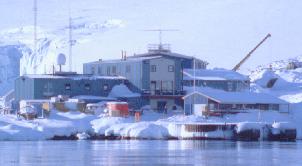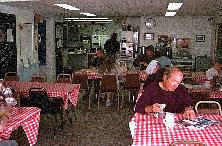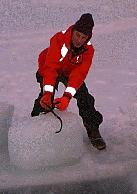Life at Palmer Station, by David Krakowski (9-29-97)
Once the frantic pace of unloading the endless boxes of cargo from the R/V
Nathaniel Palmer had subsided and the ship had set forth on its return trip to South
America, life at Palmer Station (Image 1)
returned to normal. Normality here is
 both extraordinary and routine. It is extraordinary because we live in the midst of
a beautiful and majestic landscape (Image 2)
with all sorts of exotic wildlife to
absorb our interest; routine because our world is limited to a few small buildings,
and travel in water or land to about a two mile area around Station. There are no
towns in Antarctica, no movie theaters to go to, no restaurants to frequent, and no
family to visit. The only other human beings are in other research stations spread
throughout the continent and unreachable to travel except on large ships or
airplanes. Our isolation is nearly complete!
both extraordinary and routine. It is extraordinary because we live in the midst of
a beautiful and majestic landscape (Image 2)
with all sorts of exotic wildlife to
absorb our interest; routine because our world is limited to a few small buildings,
and travel in water or land to about a two mile area around Station. There are no
towns in Antarctica, no movie theaters to go to, no restaurants to frequent, and no
family to visit. The only other human beings are in other research stations spread
throughout the continent and unreachable to travel except on large ships or
airplanes. Our isolation is nearly complete!
Palmer Station is a tiny research station run by the United States Antarctic
Program, and dedicated primarily to marine science. There are 43 beds on station,
all in bunkrooms, and we are usually filled to capacity. By comparison,
McMurdo Station one of the other U.S.A.P. stations (located on the other side of
the continent) is a veritable city of 1200 (Image 3).
Thus Palmer has a much more
personable atmosphere than her larger brethren.
Perhaps the most striking (and appealing) aspect of living at Palmer Station is the
degree of communion among its residents. We work, eat, recreate and socialize as
a group, and share all resources on station. Everyone has a mission that
contributes to the whole, but each also contributes to our lives here in many other
ways. The station Doctor doubles as the Store Clerk. The fire team consists of a
hodgepodge of individuals whose specialties are diverse, including the computer
network tech, the boating coordinator, and the electrician to name a few. There are
no custodians, so everyone must pitch in around the "house". For example each
person must volunteer for kitchen and dining room cleanup at least once weekly.
On Saturdays, everyone on station is assigned a cleaning chore and at 2:30 we all
break from our respective jobs or experiments to participate in this ritual, fondly
referred to as "house mouse". Chores range from the domestic, such as taking
out the garbage, sweeping, vacuuming, and mopping, to the industrial , such as
crushing glass bottles or loading the garbage milvan.
We live and work in two main buildings, although there are a number of smaller
shops and storage sheds, and numerous "milvans" (which are simply large cargo
 boxes) all over station. The Biolab building houses, as it's name alludes to, the
labs (Image 4). There are ten rather small laboratories
and one large wet lab,
where all the aquaria are. There are also common lab areas, where large
equipment such as the autoclave, spectrophotometers etc. are kept for everyone's
use. In addition, the building houses the galley, which is a kitchen, dining area and
a small lounge area (Image 5 & Image 6).
All the administrative offices are also found in
Biolab. Finally, on the top floor there are living quarters. Most rooms are smaller
than a two person Geneseo residence hall room and sleep two in a set of vintage
World War two navy steel bunks (Image 7). The other main building is known as
GWR, which stands for Garage, Warehouse, Recreation, exemplifying the spirit of
multipurpose use that reigns at Palmer Station. The bottom floor is a large garage,
much like that found in an automotive repair shop, with one noteable exception;
there is a household washer and dryer in one corner, for doing personal laundry.
Also on the first floor is the generator room. Inside, a diesel generator works 24-7
to provide the entire station with life sustaining electricity. There are also three
stock rooms, one for food, one for hardware, and one for miscellaneous clothing
and recreational items. Upstairs there are living quarters and a large lounge and
bar. The lounge is outfitted with an impressive movie-style entertainment center, a
stereo and a pool table. Saturday night is always a get together in the "Penguin
Pub." Also on the second floor of GWR is a large exercise room, outfitted with
weights, a stationary bike, a rowing machine, and, it is rumored, soon a treadmill.
boxes) all over station. The Biolab building houses, as it's name alludes to, the
labs (Image 4). There are ten rather small laboratories
and one large wet lab,
where all the aquaria are. There are also common lab areas, where large
equipment such as the autoclave, spectrophotometers etc. are kept for everyone's
use. In addition, the building houses the galley, which is a kitchen, dining area and
a small lounge area (Image 5 & Image 6).
All the administrative offices are also found in
Biolab. Finally, on the top floor there are living quarters. Most rooms are smaller
than a two person Geneseo residence hall room and sleep two in a set of vintage
World War two navy steel bunks (Image 7). The other main building is known as
GWR, which stands for Garage, Warehouse, Recreation, exemplifying the spirit of
multipurpose use that reigns at Palmer Station. The bottom floor is a large garage,
much like that found in an automotive repair shop, with one noteable exception;
there is a household washer and dryer in one corner, for doing personal laundry.
Also on the first floor is the generator room. Inside, a diesel generator works 24-7
to provide the entire station with life sustaining electricity. There are also three
stock rooms, one for food, one for hardware, and one for miscellaneous clothing
and recreational items. Upstairs there are living quarters and a large lounge and
bar. The lounge is outfitted with an impressive movie-style entertainment center, a
stereo and a pool table. Saturday night is always a get together in the "Penguin
Pub." Also on the second floor of GWR is a large exercise room, outfitted with
weights, a stationary bike, a rowing machine, and, it is rumored, soon a treadmill.
If there is one thing that is at a premium at Palmer Station, it is space, particularly
in the labs. It is important to be considerate of others, as everyone is in close
contact with each other, and there is nowhere to really get away to.
For temporary relief of the crowded living conditions, it is possible to take a hike
up the glacier that sits behind station (Image 8). Practically
speaking, the glacier is
just a hill of ice covered with snow, rising about 500 feet up over a half a mile
(Image 8). From the top one can see many miles on a clear day.
It is also possible
to go ice climbing at the front of the glacier, or go cross country skiing
(Image 9).
A typical day at Palmer starts bright and early at about seven in the morning.
Breakfast is served by the two full time cooks from 6:30 to 8. To their credit, the
food on station is exquisite. After a hearty meal, it is time to start work. Often this
means going straight down to the aquarium to check on our animals. The day is
 spent either in the aquarium, setting up experiments or out preparing to, cleaning
up after, or actually in the process of diving. Dives normally last less than a half
hour, but because the ocean around station is now covered by sea ice, all in all the
entire production can consume half a day (Image 10). On
dive days, the afternoon
is spent sorting animals and preparing to perform experiments. Labwork goes on
six days a week, sometimes well into the evening, and often on Sundays as well.
Science waits for no one. And our primary, even almost sole concern here is
science.
spent either in the aquarium, setting up experiments or out preparing to, cleaning
up after, or actually in the process of diving. Dives normally last less than a half
hour, but because the ocean around station is now covered by sea ice, all in all the
entire production can consume half a day (Image 10). On
dive days, the afternoon
is spent sorting animals and preparing to perform experiments. Labwork goes on
six days a week, sometimes well into the evening, and often on Sundays as well.
Science waits for no one. And our primary, even almost sole concern here is
science.
Lunch is a well anticipated break from work at midday, and the downtime is often
spent planning the afternoon activities. Dinner sometimes punctuates the work
day, but more often is also no more than a short break from work. The late
evening is usually devoted to catching up on email, watching movies in the lounge
or just generally relaxing (Image 11). The prior is particularly important, as it is
pretty much the only form daily contact those on station has with the outside
world. We are connected twice a day for about six hours at a time by a satellite
link, when we can send emails, hop on the web, or telnet to another computer in
the States. In fact the satellite is responsible for you being able to read this only a
few hours after I wrote it.
Next time we'll introduce you to our research team and describe the purpose of our
work in Antarctica.
 both extraordinary and routine. It is extraordinary because we live in the midst of
a beautiful and majestic landscape (Image 2)
with all sorts of exotic wildlife to
absorb our interest; routine because our world is limited to a few small buildings,
and travel in water or land to about a two mile area around Station. There are no
towns in Antarctica, no movie theaters to go to, no restaurants to frequent, and no
family to visit. The only other human beings are in other research stations spread
throughout the continent and unreachable to travel except on large ships or
airplanes. Our isolation is nearly complete!
both extraordinary and routine. It is extraordinary because we live in the midst of
a beautiful and majestic landscape (Image 2)
with all sorts of exotic wildlife to
absorb our interest; routine because our world is limited to a few small buildings,
and travel in water or land to about a two mile area around Station. There are no
towns in Antarctica, no movie theaters to go to, no restaurants to frequent, and no
family to visit. The only other human beings are in other research stations spread
throughout the continent and unreachable to travel except on large ships or
airplanes. Our isolation is nearly complete!